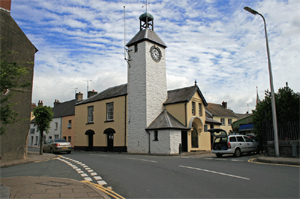
Town Hall
An old prophecy runs, 'Kidwelly was, Carmarthen is, but Laugharne will be the greater city of the three.'
Laugharne was the seventh biggest town in Wales in Tudor times and has developed differently to most towns.
It doesn't feel part of Carmarthenshire, it's like an island gently tethered to the shore.
In 1566 Carmarthen had 325 houses, Kidwelly 101, Laugharne 90 and Llanelli (which is now bigger than all three combined) had 2 houses.
This is a view of the Town Hall clock tower from the Globe opposite.
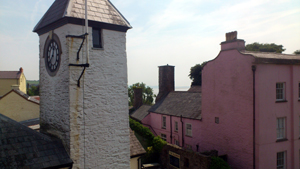
The writer Malkin in 1803 said that Laugharne, '...was the best built town in Carmarthenshire'.
Among the many fine buildings in Laugharne, the Town Hall is one of its finest.
Samuel Lewis, in his Topographical dictionary of Wales (1833) calls Laugharne '...one of the cleanest and best built in South Wales,
embosomed in an Amphitheatre of verdant hills and ornamented with the venerable remains of its ancient castle'.
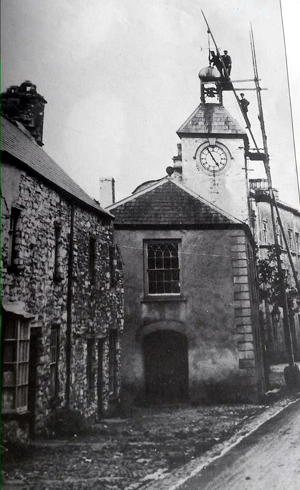
The clock tower was built in 1746 and the Town Hall renovated in 1908, which is when the pic above was taken. The court meets upstairs every other Monday to discuss the affairs of the Laugharne Corporation. There is a grand jury of 20 men, and a foreman with a Portreeve in charge. The Portreeve is like a Mayor and wears a chain of golden cockleshells.
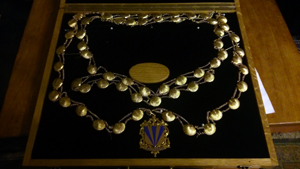
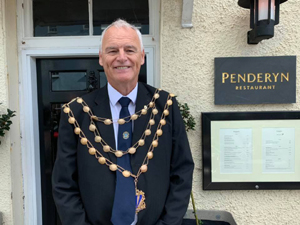
The above pic is of the current Portreeve (Feb 2021), Dai Jones. Laugharne is the only place in the UK that still carries out these ancient traditions, which adds to the township's, 'otherness'. The corporation owns land and property and was established in 1297 by Sir Guy de Brian the younger after his father started the process in the early 13th century.
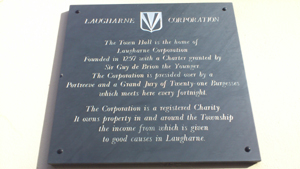
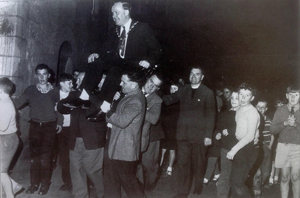
Every year on 'Big Court Night' the portreeve is carried thrice around the Town Hall in a chair, before setting off to Browns to buy everyone a drink. The pic above is from 1963.
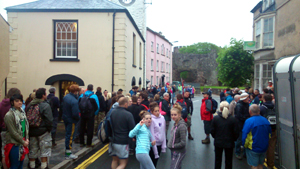
One of the rituals of the Laugharne Corporation is the Common Walk which starts from the Town Hall.
The pic above is from 2014. It takes place on Whit Monday every three years. This 'beating of the bounds' of Laugharne means that
the corporation can continue in its business. It is headed by Guides, Colour-bearers, Halberdiers and Mattock-Men.
The Walk is around 20 kms and takes about 8 hours. Why so long? Well, have you ever queued with 200 people in a stream to get through a
small gap in a hedge? Probably not. Down lanes, over fences, through hedges, across farmland, and when the walk arrives at the estuary
there are large mud crevasses to clamber over. Plus, there are beer stops provided by the Attorneys en route as well, which can slow things up a bit.
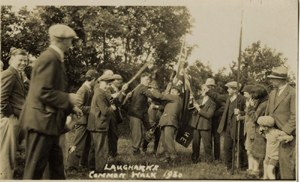
An ancient tradition is for some of the burgesses to ask a young person the name of a particular spot - see above in 1930.
These are known as 'Hoisting Places'. Examples include, The Nuck, Bony State Lane, Oaten Cake and Cheese, Fulling Mill, Hugh Lake, Merry Moor,
Molden Vit, Shambles and our favourite, Lellington in the County Of Warweek. These names go back hundreds of years and if the young
person can't name the spot, they are held upside down by the constables and gently beaten with sticks.
Originally this was a way of encouraging local youths to be knowledgeable about the lands owned by the Corporation.
This is Laugharne, and there is nowhere else like it.
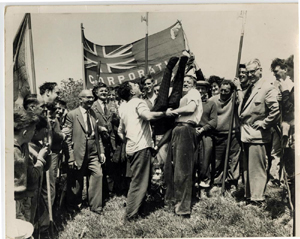
Another poor young person held upside down in the common walk of 1963.
Included in picture are Foreman Ralph Tucker, Recorder Fleming Williams and Portreeve Douglas Bradshaw.
Sid Edwards and Trevor John are the 'hoisters' and Eric Pearce is the Halberdier.
A 'Halberd' was a two-handed pole weapon that came to prominent use during the 14th, 15th, and 16th centuries for use against armoured men, especially on horseback.
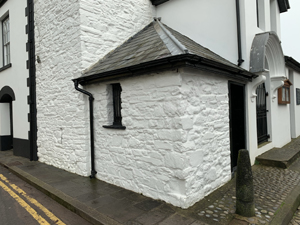
The Town Hall also houses a cell where troublemakers would be held, known as 'The Lock Up'.
Legend has it that the last person to be locked in the cell overnight was a drunken aggressive Chinese man back in the 1970s.
This is Laugharne.
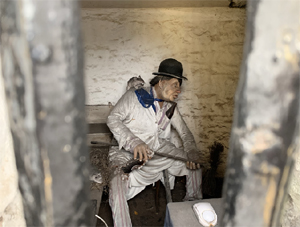
The cell contains a fibre-glass figure of Waldo Williams a character known for his 'pleasures' from Under Milk Wood.
This is one of the few references to Dylan Thomas in the township, for as far as Laugharne is concerned, he was just another local.
One night a drunk was locked up. His friends poured beer into his mouth through a tea pot and the magistrate was astonished to see he was still drunk the following day.
In 1650 there was a request to create a pillory and stocks. The stocks were in behind the Town Hall but have long gone.
Good job too as Laugharne is a place of ancient traditions, and the stocks would probably still be used on a regular basis!
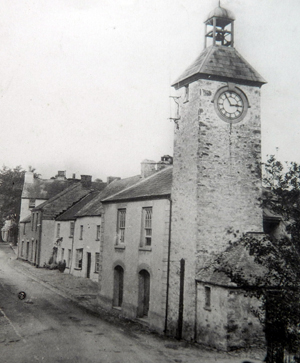
Laugharne has seen some changes over the years. As the industrial revolution, trains, tourism passed it by, it remained off
the beaten track and firmly independent. Seemingly thriving in 1840, by 1871 Worrall's List stated that, 'The business of the town is declining.
Many grand houses stand empty with no semblance of trade except for local produce exported to Bristol.'
The population declined from the usual 2000 to 1742, suggesting that families moved away to work.
The clock tower, ticking since 1746 has seen many things come and go, and hopefully will stand for a few centuries more, trying to tick time
away in a timeless place. Which nicely leads us to the clock face and mechanism.
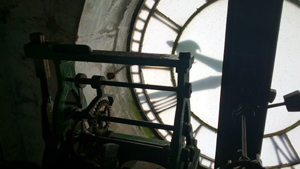
However, by 1880 Mary Curtis (Redford House) wrote that 'Laugharne was well known in the salons of London.'
Certainly, with three ballrooms, grand houses and a literary connection maybe Laugharne in the 1880s was similar to Mustique in the 1980s.
Laugharne is full of mysteries and story-telling, but for the first time in its long and colourful history it is under threat.
This is because of the increasing number of holiday homes. More and more houses stand silent half the year and more, and silent houses tell no stories.

The Town Hall
from the castle tower, c.1900
2nd Voice talks about a man being, '...as tall as the clock tower,' and that the clock, '...tells the time backwards,' both references to Laugharne Town Hall.
The map Dylan drew of Llareggub, which many say looks like Newquay - 40 miles to the north, where he lived in 1944 - clearly features the clock of Laugharne Town Hall.
But it started in Newquay in Quite Early One Morning and Mr Pritchard of 'Ogmore-Pritchard' was a Newquay bank manager, but it was Laugharne that
helped him finish his quest. Dylan had some weird conceit when it was called The Town That Was Mad that the townspeople had to appear before Captain Cat to
prove that they were mad. He ditched that when he lived in Laugharne as he knew humour, poignancy and ad hoc tales could power the piece, rather than some device.

copyright © 2021 Laugharne Lines
all rights reserved